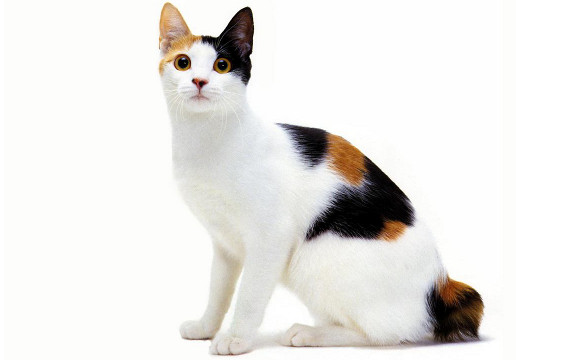History and Origins
The Japanese Bobtail cat breed has a deep-rooted history intertwined with Japanese culture and folklore. This breed has been present in the Far East for centuries, with references to short-tailed cats appearing in early Japanese folklore. One of the most famous legends is of the Maneki-Neko, a small, short-tailed female cat associated with good fortune, depicted with one paw raised in welcome at the Gotokuji Temple near Tokyo.
While the exact origins of the Japanese Bobtail remain unclear, it is believed that domestic cats were introduced to Japan from China and Korea in the early sixth century. By the early seventeenth century, the bobbed tail was a common trait among Japanese cats. Tricolored cats with pom-pom tails, known as Mi-Ke, were revered for their grace and beauty and were often kept in temples and the homes of the Imperial Japanese families.
During the thirteenth to fifteenth centuries, the Japanese government released cats to protect the silk industry from mice, transforming the Japanese Bobtail from a pampered household pet to a street cat. Despite this, the breed retained its cultural significance and continued to be associated with good luck.
The Japanese Bobtail was first documented in the United States in 1908, but it wasn’t until the 1960s that the breed gained formal recognition. Breeder Elizabeth Freret imported three Japanese Bobtails from Japan in 1968, establishing a formal breeding and exhibiting program. In 1969, the Cat Fanciers’ Association (CFA) accepted Japanese Bobtails for registration, and by 1976, they gained Championship status.
Physical Characteristics
The Japanese Bobtail is known for its distinctive pom-pom tail, which is the result of a recessive gene. The tail, typically about 4 inches (10 cm) long, curls into a corkscrew shape, giving it a unique appearance. This breed’s tail fur camouflages the underlying bone structure, which varies greatly from cat to cat.
Japanese Bobtails have a medium-sized, muscular build with long, slender legs and a well-proportioned body. Their head is triangular with high cheekbones and large, expressive eyes that can be of any color. The coat of the Japanese Bobtail can be short or long, and it comes in a variety of colors and patterns, with the tricolored Mi-Ke being particularly prized.
Temperament and Personality
Japanese Bobtails are known for their playful, curious, and intelligent nature. They are highly social cats that enjoy interacting with people and other pets. Their adaptability makes them excellent companions for households with children and other animals. Japanese Bobtails are also known for their vocal nature, producing a wide range of tones that some breeders describe as “singing.”
These cats are active but not overly so, and they enjoy interactive play. Their bold and confident demeanor makes them easy to show and a joy to have as a pet. Japanese Bobtails are known for their affectionate nature, often following their owners around the house and involving themselves in daily activities.
Health and Care
The Japanese Bobtail is a generally healthy breed with no known genetic defects associated with their unique tail structure. Regular veterinary check-ups are essential to ensure their continued health and well-being. Maintaining a balanced diet and providing regular exercise are crucial for keeping these cats healthy.
The Japanese Bobtail’s coat requires minimal grooming. For shorthaired Bobtails, occasional brushing is sufficient to keep their coat in good condition. Longhaired Bobtails may require more frequent grooming to prevent matting and tangles.
Living with a Japanese Bobtail
Japanese Bobtails thrive in environments where they receive plenty of attention and interaction. They are highly active and enjoy climbing, so providing vertical spaces like cat trees can keep them entertained. These cats are also known for their intelligence and can be trained to perform tricks, enhancing their bond with their human companions.
Given their social nature, Japanese Bobtails may become lonely if left alone for extended periods. It is beneficial to have another pet to keep them company. These cats are known for their loyalty and will often follow their owners around the house, seeking to be involved in all activities.
Breeding and Genetics
Breeding Japanese Bobtails requires an understanding of their unique genetic makeup. The gene responsible for their distinctive tail is recessive, meaning that both parents must carry the gene for it to be expressed in their offspring. Responsible breeders focus on maintaining genetic diversity and health, ensuring the breed’s continued vitality.
Conclusion
The Japanese Bobtail is a remarkable breed with a rich cultural history and a delightful personality. Their unique appearance, playful nature, and affectionate demeanor make them a wonderful addition to any family. Whether you are a seasoned cat owner or new to feline companionship, the Japanese Bobtail offers a rewarding and engaging pet experience.
FAQs
Q: Are Japanese Bobtails good with children? A: Yes, they are excellent with children and enjoy interactive play.
Q: Do Japanese Bobtails require a lot of grooming? A: No, their coat is relatively low-maintenance. Shorthaired Bobtails require occasional brushing, while longhaired Bobtails may need more frequent grooming.
Q: Are Japanese Bobtails prone to any health issues? A: They are generally healthy with no known genetic defects related to their tail. Regular veterinary care is essential.
Q: How active are Japanese Bobtails? A: They are very active and enjoy playful activities. They need mental and physical stimulation to stay happy and healthy.
Q: Do Japanese Bobtails get along with other pets? A: Yes, they are social and can get along well with other cats and dogs, especially if properly socialized.

